What Does Dental Sense Mean?
What Does Dental Sense Mean?
Blog Article
How Dental Sense can Save You Time, Stress, and Money.
Table of ContentsAbout Dental SenseGet This Report on Dental SenseIndicators on Dental Sense You Need To KnowWhat Does Dental Sense Do?
are clinical tools surgically dental implanted into the jaw to restore an individual's ability to eat or their appearance. They provide support for artificial (phony) teeth, such as crowns, bridges, or dentures. When a tooth is lost due to injury or illness, a person can experience problems such as quick bone loss, malfunctioning speech, or adjustments to chewing patterns that lead to pain.Oral implant systems are composed of a dental implant body and oral implant joint and may also include a joint addiction screw. Professional teeth whitening. The dental implant body is operatively put in the jawbone in place of the tooth's origin. The dental implant joint is typically affixed to the implant body by the joint addiction screw and expands through gums right into the mouth to support the attached fabricated teeth
(https://www.pubpub.org/user/matthew-music)Framework of The Oral Implant System selecting oral implants, talk to your dental supplier regarding the possible advantages and dangers, and whether you are a prospect for the treatment. Things to take into consideration: Your total wellness is a vital consider identifying whether you are a good prospect for oral implants, how much time it will certainly take to recover, and the length of time the implant might remain in location.
Smoking may affect the healing process and decrease the lasting success of the implant. The healing process for the dental implant body might take numerous months or longer, during which time you typically have a momentary abutment instead of the tooth. the dental implant procedure: Very carefully comply with the oral hygiene instructions given to you by your oral supplier.
Rumored Buzz on Dental Sense
Implant failing can cause the requirement for one more operation to repair or replace the dental implant system. Restores the capability to eat Restores cosmetic look Assists maintain the jawbone from shrinking due to bone loss Preserves the health of the surrounding bone and gum tissues Helps keep adjacent (close-by) teeth stable Enhances lifestyle Damage to bordering natural teeth throughout dental implant positioning Injury to the surrounding tissues throughout surgery, such as sinus opening Injury during surgical procedure (as an example, crack of bordering jawbone) Inadequate function, such as really feeling like the teeth do not attack with each other normally A sensation that the tooth is loosened or turning in place resulting from an abutment screw loosening up Implant body failing (looseness of the implant body) because of systemic infection, which might be most likely in clients with unchecked diabetics issues as a result of neighborhood infection in bone and gum tissues sustaining the implant body due to delayed healing, which may be most likely in patients who smoke Difficulty cleaning up the periodontals around the dental implant, leading to inadequate dental health Unattended periodontal disease Post-surgical pins and needles because of nerve impingement or damage Constantly alert healthcare suppliers and imaging service technicians that you have oral implants prior to any magnetic resonance imaging (MRI) or x-ray treatments.
FDA is not knowledgeable about any type of negative occasions reported for MRI or x-ray treatments with oral implants. Oral implants systems are commonly made of materials that comply with international consensus standards of the International Organization for Standardization (ISO) or ASTM International. These criteria have information of what makes a secure material.

An oral implant is a structure that changes a missing tooth. With screw-like tools, the doctor inserts a dental implant into the jawbone, and it functions as an anchor for a fabricated tooth, called a crown. A device called an abutment connects the man-made tooth to the oral implant. The crown is tailor-made to fit the individual's mouth and match the shade of their teeth.
The Best Guide To Dental Sense
Some people are not eligible for dental implant surgery. It is for dental specialists to run on individuals with: acute illnessuncontrollable metabolic diseasebone or soft tissue condition or infectionIf these issues are solved, an individual can have the surgical procedure. In, dental cosmetic surgeons avoid operating on individuals with: If individuals with any one of the above go through dental implant surgical procedure, there is a greater threat of the implant stopping working.

Dental dental implant surgical treatment is a personalized process. Give you time to heal. Affix the article and last crown, bridge or denture.
Next, your doctor will meticulously position the oral implant into your jaw. Your cosmetic surgeon will rearrange your gums and shut the cut with stitches. If your dental implant is near the front of your mouth, your dental practitioner will certainly make a momentary tooth for you to use till you recover. This way, you won't have a space in your smile while you browse around this web-site recuperate.
Facts About Dental Sense Uncovered
Your supplier can tell you what to expect in your scenario. Throughout the healing stage, your jawbone needs to fuse to the oral implant. This process, called osseointegration, is essential for stability and long-term success. This process can take anywhere from 3 to 9 months. In some instances, it may take longer.
Once your implant heals, your dentist can attach the abutment (tiny adapter article) and your last repair (crown, bridge or denture). This usually takes regarding one hour to finish and may require a second small surgery. You should not really feel any kind of discomfort during your dental implant treatment since your supplier will make use of medicine to numb your gums.
Report this page